Unit 3 How do you get to school Period 4 Section B(2a-2d)课件(共49张PPT,内嵌音频)
文档属性
| 名称 | Unit 3 How do you get to school Period 4 Section B(2a-2d)课件(共49张PPT,内嵌音频) | 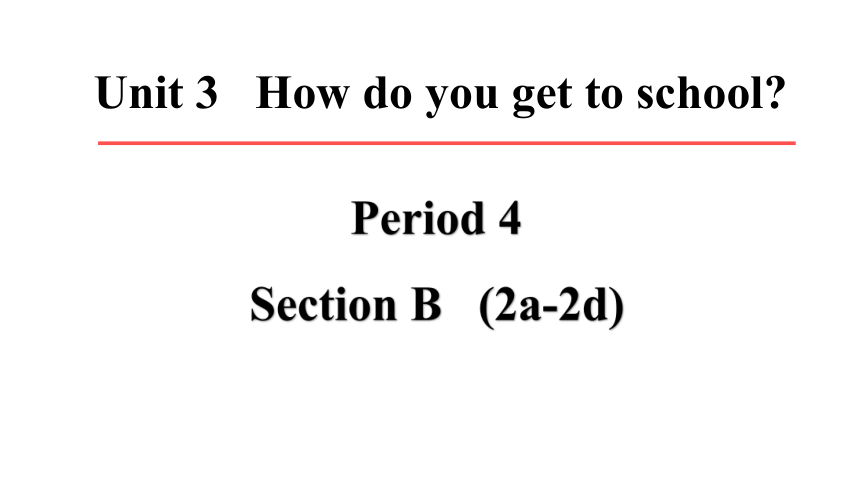 | |
| 格式 | pptx | ||
| 文件大小 | 16.2MB | ||
| 资源类型 | 教案 | ||
| 版本资源 | 人教新目标(Go for it)版 | ||
| 科目 | 英语 | ||
| 更新时间 | 2023-12-18 09:46:56 | ||
图片预览

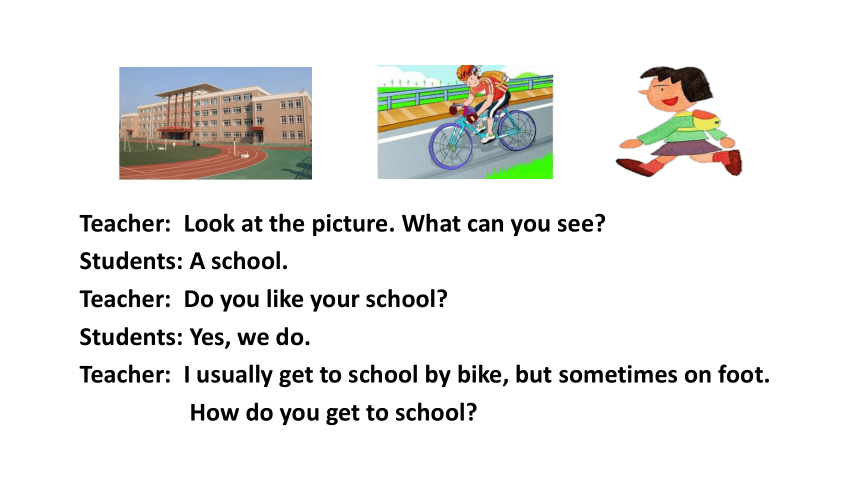

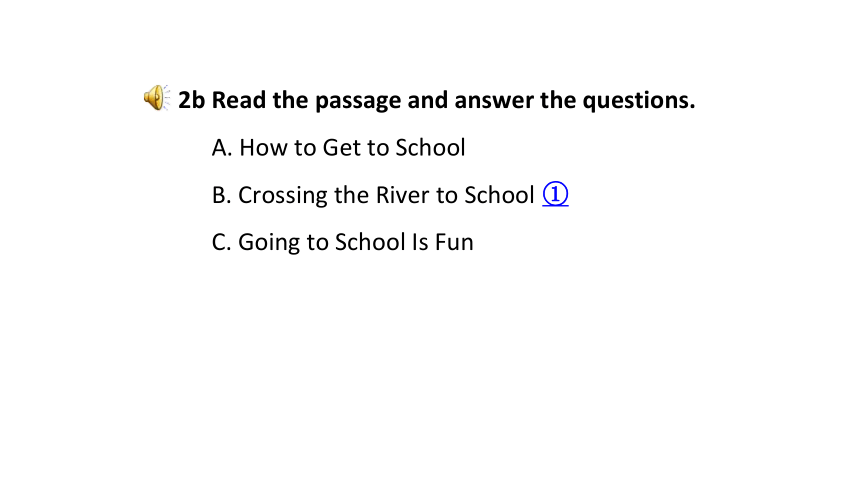

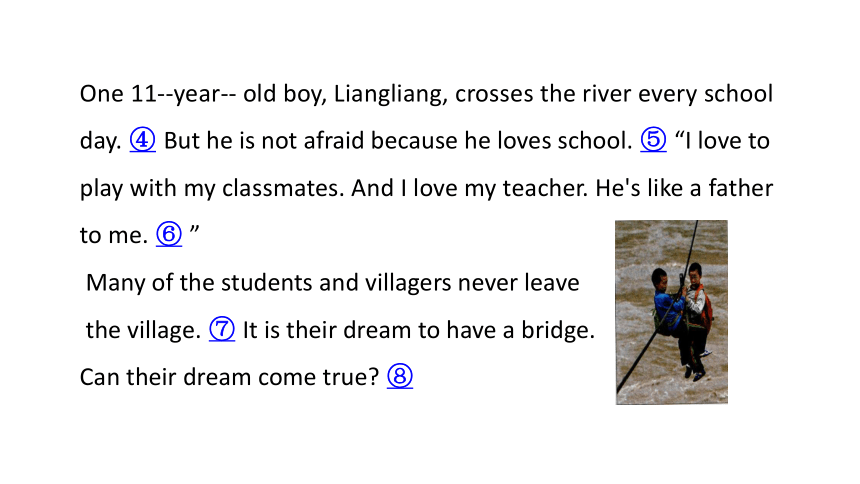
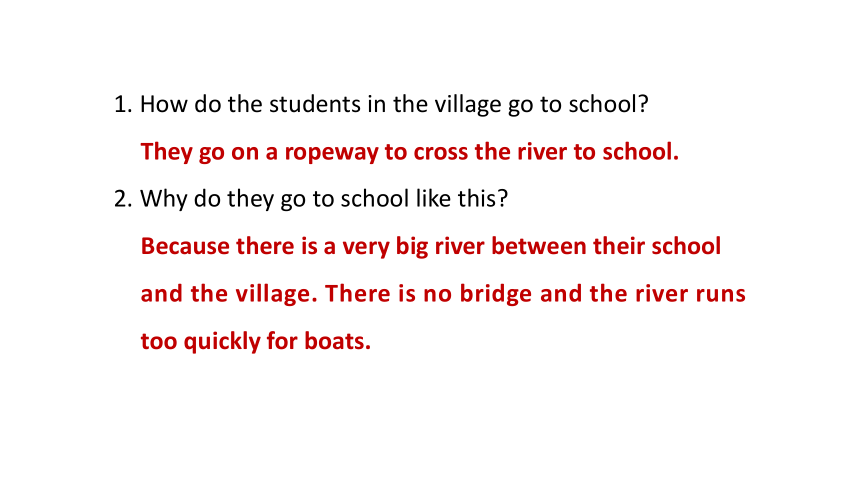
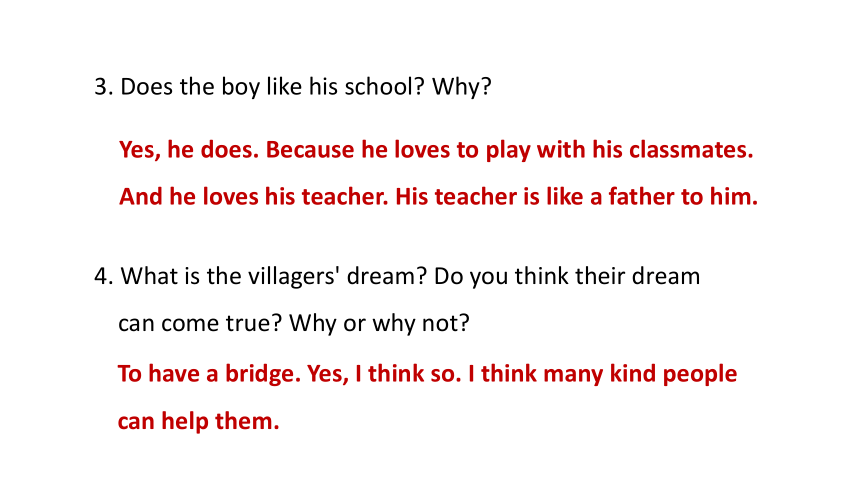
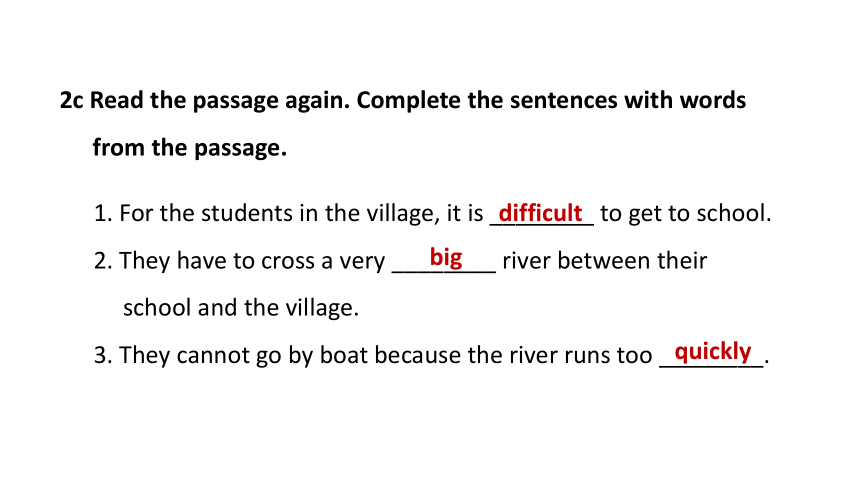


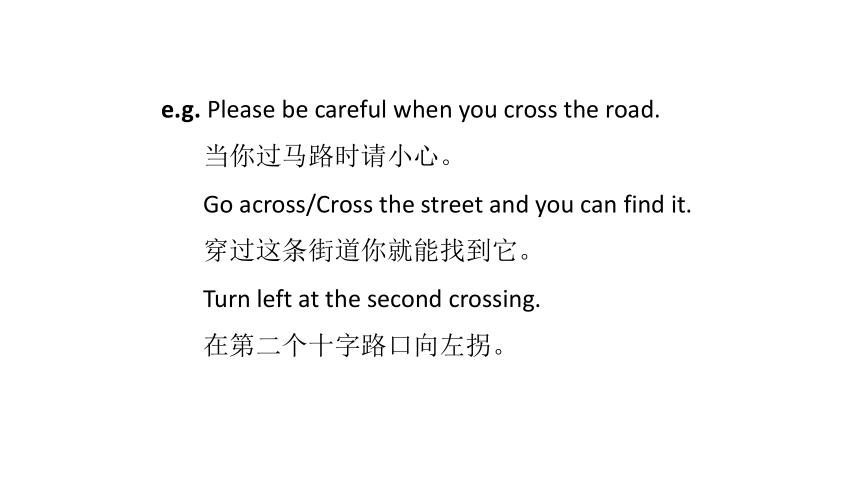
文档简介
(共49张PPT)
Period 4
Section B (2a-2d)
Unit 3 How do you get to school
Teacher: Look at the picture. What can you see
Students: A school.
Teacher: Do you like your school
Students: Yes, we do.
Teacher: I usually get to school by bike, but sometimes on foot. How do you get to school
2a Look at the picture and title below. Guess what the passage is about.
2b Read the passage and answer the questions.
A. How to Get to School
B. Crossing the River to School ①
C. Going to School Is Fun
Crossing the River to School
How do you get to school Do you walk or ride a bike Do you go by bus or by train For many students, it is easy to get to school. ② But for the students in one small village in China, it is difficult. There is a very big river between their school and the village. ③ There is no bridge and the river runs too quickly for boats. So these students go on a ropeway to cross the river to school.
One 11 -year- old boy, Liangliang, crosses the river every school day. ④ But he is not afraid because he loves school. ⑤ “I love to play with my classmates. And I love my teacher. He's like a father to me. ⑥ ”
Many of the students and villagers never leave
the village. ⑦ It is their dream to have a bridge.
Can their dream come true ⑧
1. How do the students in the village go to school
2. Why do they go to school like this
They go on a ropeway to cross the river to school.
Because there is a very big river between their school
and the village. There is no bridge and the river runs too quickly for boats.
3. Does the boy like his school Why
4. What is the villagers' dream Do you think their dream
can come true Why or why not
Yes, he does. Because he loves to play with his classmates. And he loves his teacher. His teacher is like a father to him.
To have a bridge. Yes, I think so. I think many kind people can help them.
1. For the students in the village, it is ________ to get to school.
2. They have to cross a very ________ river between their
school and the village.
3. They cannot go by boat because the river runs too ________.
difficult
big
quickly
2c Read the passage again. Complete the sentences with words from the passage.
4. It is not easy to cross the river on a ropeway, but the boy is
not ________.
5. The students and villagers want to have a bridge. Can their
dream come ________
afraid
true
①Crossing the River to School
cross /kr s/, /kr s / v. 横过;越过
考点1
辨析:cross,across 和crossing
cross 动词,意为“横过;越过”。 cross=go across
across 介词或副词,意为“横过” crossing 名词,意为“十字路口”。 e.g. Please be careful when you cross the road.
当你过马路时请小心。
Go across/Cross the street and you can find it.
穿过这条街道你就能找到它。
Turn left at the second crossing.
在第二个十字路口向左拐。
拓展:(1) cross 还可作名词,意为“十字形记号;叉字形记号”。
e.g. Put a cross on the map to show where our school is.
在地图上画个十字,标出我们学校的位置。
(2) 作形容词,意为“生气的”。
e.g. The teacher is cross because Li Ming is late for class.
老师很生气因为李明上课迟到了。
返回
一语辨异:
Go across/Cross the street and turn left at the second crossing.
穿过这条街,在第二个十字路口向左拐。
②For many students, it is easy to get to school.
It is + adj. + to do sth. 做某事是……的
It 为形式主语,后面的动词不定式“to do sth.”是句子的真正主语。本句为了强调,把“For many students”放到了句首。正常的语序应是“It is easy for many students to get to school.”。
考点2
考向
对……来说;对……而言
温馨提示:英语中,当动词不定式短语或动名词(短语)作主语时,谓语动词通常用单三形式;且此时常用it作形式主语,将动词不定式放在后面。
e.g. It is difficult to get there. =To get there is difficult.
到达那儿是困难的。
辨析:It is + adj. + for sb. + to do sth. 与It is + adj. + of sb. + to do sth.
It is + adj. + for sb. + to do sth. for 后跟对象,意为“就……而言;对……
来说”,句中的形容词是描述事物特征的。
It is + adj. + of sb. + to do sth. 意为“某人做某事是……的”。形容词是表示人的特点、性格或特征的。
e.g. It is difficult for me to speak French. 对我来说,说法语是困难的。
It is nice of you to help me. 帮助我你真是太好了。
小贴士:
描述事物特征的词,如easy, difficult, important 等。
表示人物性格、品质的词,如kind, nice, clever 等。
考题1:[福建] It’s important for us _____ hard in order to have a better life.
A. work B. to work C. working
考题2:[绥化] —It is convenient _____ us _____ things online.
—So it is.
A. for; to buy B. of; to buy C. for; buy
B
A
many/meni/ det. & pron. 许多
考点3
辨析:many, much 与lots of
many 修饰 可数名词复数 There are many trees in the park.
公园里有许多树。
much 修饰 不可数名词 It takes him much time to get there.
他花费了很多时间到达那里。
lots of = a lot of 既可修饰可数名词复数,又可修饰不可数名词 You can see lots of trees/water over there. 在那边你能看到许多树/ 水。
many
lots of
much
trees 许多树
water 许多水
返回
③There is a very big river between their school and the village.
there be 句型
“There be + 某人 / 某物+ 某地 / 某时.”,意为“某地或某时有某人或某物”。
e.g. There are four men and a woman using computers.
有四位男士和一位女士正在使用电脑。
There is an apple and two pears on the table.
桌子上有一个苹果和两个梨。
考点4
考向
特别提醒:当有两个或两个以上并列主语时,there be句型遵循“就近原则”,即be动词取决于离它最近的名词的单复数。
考题3:[宿迁] —There _______ a lot of new magazines in our school reading room.
—Oh, really Shall we go there this afternoon
A. is B. was C. are D. were
C
考题4:[恩施] There ________ some milk and several apples in the fridge.
A. is B. are C. be
【点拨】“there be”句型遵循“就近原则”,离be 动词最近的名词milk 是不可数名词, 所以be 动词要用is。
A
(高频) between /b 'twi n/ prep. 介于……之间
考点5
辨析:between 与among
between 一般用于两者之间,其宾语往往是表示两者的名词或代词,或是由and 连接的两个人或事物。
among 表示三者或三者以上的人或物之间,宾语可以是复数名词或代词,也可以是集合名词。
e.g. This village lies between two mountains.
这个村庄位于两座山之间。
That village lies among the mountains.
那个村庄位于群山之中。
There is a road between this village and that one.
在这个村庄和那个村庄之间有一条路。
between...and... 意为
“在……和……之间”。
特别提醒: 表示“三个或三个以上的人或物中的每两个之间”用between。
考题5:[新疆] 约翰尽力在工作和娱乐中获得平衡。
John does his best to keep the balance _________ work _________ play.
返回
between
and
④One 11-year -old boy, Liangliang, crosses the river every school day.
(高频) 11-year-old 11 岁的
是由“基数词+连字符+ 可数名词单数形式+连字符+ 形容词”构成的复合形容词,常用来作定语。
e.g. This is an 8-month-old baby. 这是一个八个月大的婴儿。
It’s a 300-meter-long bridge. 它是一座长300 米的桥。
考点6
考向
小贴士: 8 的英文是eight,以元音音素开头,前面的不定冠词用an。
辨析: 11-year-old 与11 years old
11-year-old 用连字符连接,中间的名词用单数,在句中作定语。
11 years old 不用连字符连接,中间的名词用复数,在句中作表语。
由“基数词+ 单数名词+形容词”构成的复合形容词的特点:
① 三个词之间要有连字符;② 中间的名词必须是单数;
③ 只能作定语,不可作表语。
两者可以互换使用。
e.g. He is an 11-year-old boy. 他是一个11 岁大的男孩。
= The boy is 11 years old. 这个男孩11 岁了。
拓展:此类复合形容词的结构中,形容词还可以是long 长的/wide 宽的/high 高的/tall 高的/deep 深的/thick 厚的……
e.g. a three-meter-long snake 一条3 米长的蛇
考题6:—The _______ girl has won the prize of International Master of Memory.
—Wow, she’s great, isn’t she
A. ten-year-old B. ten-years-old
C. ten year old D. ten years old
返回
A
⑤But he is not afraid because he loves school.
afraid / 'fre d/ adj. 害怕;畏惧
e.g. Why are you so afraid 你为什么这么害怕?
Cathy is afraid of the dog. 凯西怕狗。
I’m afraid (that) you’ll miss your favorite subject.
恐怕你将错过你最喜欢的学科。
拓展:I’m afraid so /not. 意为“恐怕是这样/ 恐怕不是这样”。
考点7
辨析: be afraid to do sth.与 be afraid of (doing) sth.
be afraid to do sth. 表示“害怕做某事”,即主语对做某事感到恐惧。 He was afraid to go out alone at night.
他害怕晚上独自外出。
11 years old 表示主语内心不情愿做某事, 担心某事可能发生。 She was afraid of waking her husband up.
她怕吵醒她丈夫。
— Rose isn’t here today. Is she ill
罗丝今天不在这里。她生病了吗?
— I am afraid so. I saw her at the doctor’s this morning.
恐怕是这样。今天早上我在诊所看到过她。
afraid 的常见用法:
① be afraid of sb./sth. 害怕某人/某物
② be afraid to do sth.害怕/ 不敢做某事
③ be afraid of doing sth. 害怕做某事
④ be afraid + (that) 从句 害怕……
考题7:I ____________(害怕) crossing the street because there is always too much traffic.
am afraid
返回
⑥He’s like a father to me.
like /la k/ prep. 像;怎么样
考点8
后可接名词或代词作宾语
辨析: be like 与look like
be like “像”,多指性格、品质方面像,也可指外貌上像。
look like “看起来像”,指外观或外貌上像。
e.g. The girl is like her sister. They’re both outgoing.
这个女孩像她姐姐。她们都很外向。
The cloud looks like a horse.
这朵云看上去像一匹马。
拓展:like 用作动词,意为“喜欢”。常用搭配:like sth. 喜欢某物;like doing/to do sth. 喜欢做某事
e.g. We like to play the guitar. 我们喜欢弹吉他。
Jack likes riding a bike to school. 杰克喜欢骑自行车去学校。
返回
like 的相关句型:
① What’s sb. like
某人怎么样? (侧重于询问性格、品质)
② What does sb. Look like
某人长得怎么样?(侧重于询问外表)
⑦Many of the students and villagers never leave the village.
leave /li v/ v. 离开
e.g. Let’s leave at 6:00.
让我们6 点离开吧。
He leaves home early every day.
每天他早早地离开家。
考点9
不及物动词
及物动词
辨析: leave, leave for 与leave A for B
leave 后跟的地点为“出发地” When do you leave school
你什么时候离校?
leave for 后跟的地点为“目的地” ,意为“动身前往某地”。 He will leave for Shanghai tomorrow.
明天他将动身去上海。
leave A for B A 为“出发地”B 为“目的地” ,意为“离开A地前往B 地”。 He wants to leave Beijing for Shanghai.
他想离开北京去上海。
拓展:leave 还可意为“留下;丢下;剩余”等。
e.g. I left my schoolbag at home.
我把我的书包落在家了。
Hurry up! There’s little time left.
快点!几乎没有时间了。
考题8:[铜仁] Remember(记得) to turn off the lights when you __________ (离开) the classroom.
【点拨】主句“Remember(记得) to turn off the lights”是祈使句,所以从句是一般现在时,主语是you,谓语动词用原形。
leave
返回
⑧Can their dream come true
dream /dri m/ n. 梦想;睡梦 v. 做梦
考点10
可数名词,意为 “梦想;睡梦” He has dreams every night.
他每天晚上都做梦。
His dream is to be an astronaut.
他的梦想是成为一名宇航员。
动词,意为 “做梦” She often dreams at night.
她晚上经常做梦。
拓展:dream of /about“梦想;梦见”,后接动词时,要用动词的 ing 形式,或者后面直接接名词。
e.g. Many people dream of becoming famous.
很多人梦想成名。
I dreamt about a plane last night.
昨天晚上我梦见了一架飞机。
一语辨异:He is dreaming a dream.他正在做梦。
come true 实现
come true 是不及物动词短语,主语常是梦想(dream) 、希望(wish) 或目标等,其后不能跟宾语。make... come true 意为“使……实现”。
e.g. Happiness is about having each tiny wish come true.
幸福是每一个微小愿望的实现。
How can you make your dream come true
你怎样让你的梦想实现?
考点11
考向
与come 相关的短语:
come on 加油
come in 进来
come out 出版;开花
come back 回来
come from 来自……
come over 过来;拜访
考题9:[武威] 我们将一起努力实现梦想。
We’ll work together to make our dreams ___________.
come true
true /tru / adj. 真的;符合事实的
e.g. I think you are a true friend.
我觉得你是一个真正的朋友。
Tom can tell us the truth. 汤姆可以告诉我们真相。
He truly loves his children. 他由衷地爱他的孩子们。
考点12
true 的词形变化:truth n. 真相;事实
truly adv. 真正,确实
返回
本节课主要练习了听力,学习了“过河去上学”这篇课文,掌握了知识点宾语从句、cross、It’s+ adj +for/of sb. to do、动词不定式作目的状语、复合形容词、afraid、come true等的用法。
Period 4
Section B (2a-2d)
Unit 3 How do you get to school
Teacher: Look at the picture. What can you see
Students: A school.
Teacher: Do you like your school
Students: Yes, we do.
Teacher: I usually get to school by bike, but sometimes on foot. How do you get to school
2a Look at the picture and title below. Guess what the passage is about.
2b Read the passage and answer the questions.
A. How to Get to School
B. Crossing the River to School ①
C. Going to School Is Fun
Crossing the River to School
How do you get to school Do you walk or ride a bike Do you go by bus or by train For many students, it is easy to get to school. ② But for the students in one small village in China, it is difficult. There is a very big river between their school and the village. ③ There is no bridge and the river runs too quickly for boats. So these students go on a ropeway to cross the river to school.
One 11 -year- old boy, Liangliang, crosses the river every school day. ④ But he is not afraid because he loves school. ⑤ “I love to play with my classmates. And I love my teacher. He's like a father to me. ⑥ ”
Many of the students and villagers never leave
the village. ⑦ It is their dream to have a bridge.
Can their dream come true ⑧
1. How do the students in the village go to school
2. Why do they go to school like this
They go on a ropeway to cross the river to school.
Because there is a very big river between their school
and the village. There is no bridge and the river runs too quickly for boats.
3. Does the boy like his school Why
4. What is the villagers' dream Do you think their dream
can come true Why or why not
Yes, he does. Because he loves to play with his classmates. And he loves his teacher. His teacher is like a father to him.
To have a bridge. Yes, I think so. I think many kind people can help them.
1. For the students in the village, it is ________ to get to school.
2. They have to cross a very ________ river between their
school and the village.
3. They cannot go by boat because the river runs too ________.
difficult
big
quickly
2c Read the passage again. Complete the sentences with words from the passage.
4. It is not easy to cross the river on a ropeway, but the boy is
not ________.
5. The students and villagers want to have a bridge. Can their
dream come ________
afraid
true
①Crossing the River to School
cross /kr s/, /kr s / v. 横过;越过
考点1
辨析:cross,across 和crossing
cross 动词,意为“横过;越过”。 cross=go across
across 介词或副词,意为“横过” crossing 名词,意为“十字路口”。 e.g. Please be careful when you cross the road.
当你过马路时请小心。
Go across/Cross the street and you can find it.
穿过这条街道你就能找到它。
Turn left at the second crossing.
在第二个十字路口向左拐。
拓展:(1) cross 还可作名词,意为“十字形记号;叉字形记号”。
e.g. Put a cross on the map to show where our school is.
在地图上画个十字,标出我们学校的位置。
(2) 作形容词,意为“生气的”。
e.g. The teacher is cross because Li Ming is late for class.
老师很生气因为李明上课迟到了。
返回
一语辨异:
Go across/Cross the street and turn left at the second crossing.
穿过这条街,在第二个十字路口向左拐。
②For many students, it is easy to get to school.
It is + adj. + to do sth. 做某事是……的
It 为形式主语,后面的动词不定式“to do sth.”是句子的真正主语。本句为了强调,把“For many students”放到了句首。正常的语序应是“It is easy for many students to get to school.”。
考点2
考向
对……来说;对……而言
温馨提示:英语中,当动词不定式短语或动名词(短语)作主语时,谓语动词通常用单三形式;且此时常用it作形式主语,将动词不定式放在后面。
e.g. It is difficult to get there. =To get there is difficult.
到达那儿是困难的。
辨析:It is + adj. + for sb. + to do sth. 与It is + adj. + of sb. + to do sth.
It is + adj. + for sb. + to do sth. for 后跟对象,意为“就……而言;对……
来说”,句中的形容词是描述事物特征的。
It is + adj. + of sb. + to do sth. 意为“某人做某事是……的”。形容词是表示人的特点、性格或特征的。
e.g. It is difficult for me to speak French. 对我来说,说法语是困难的。
It is nice of you to help me. 帮助我你真是太好了。
小贴士:
描述事物特征的词,如easy, difficult, important 等。
表示人物性格、品质的词,如kind, nice, clever 等。
考题1:[福建] It’s important for us _____ hard in order to have a better life.
A. work B. to work C. working
考题2:[绥化] —It is convenient _____ us _____ things online.
—So it is.
A. for; to buy B. of; to buy C. for; buy
B
A
many/meni/ det. & pron. 许多
考点3
辨析:many, much 与lots of
many 修饰 可数名词复数 There are many trees in the park.
公园里有许多树。
much 修饰 不可数名词 It takes him much time to get there.
他花费了很多时间到达那里。
lots of = a lot of 既可修饰可数名词复数,又可修饰不可数名词 You can see lots of trees/water over there. 在那边你能看到许多树/ 水。
many
lots of
much
trees 许多树
water 许多水
返回
③There is a very big river between their school and the village.
there be 句型
“There be + 某人 / 某物+ 某地 / 某时.”,意为“某地或某时有某人或某物”。
e.g. There are four men and a woman using computers.
有四位男士和一位女士正在使用电脑。
There is an apple and two pears on the table.
桌子上有一个苹果和两个梨。
考点4
考向
特别提醒:当有两个或两个以上并列主语时,there be句型遵循“就近原则”,即be动词取决于离它最近的名词的单复数。
考题3:[宿迁] —There _______ a lot of new magazines in our school reading room.
—Oh, really Shall we go there this afternoon
A. is B. was C. are D. were
C
考题4:[恩施] There ________ some milk and several apples in the fridge.
A. is B. are C. be
【点拨】“there be”句型遵循“就近原则”,离be 动词最近的名词milk 是不可数名词, 所以be 动词要用is。
A
(高频) between /b 'twi n/ prep. 介于……之间
考点5
辨析:between 与among
between 一般用于两者之间,其宾语往往是表示两者的名词或代词,或是由and 连接的两个人或事物。
among 表示三者或三者以上的人或物之间,宾语可以是复数名词或代词,也可以是集合名词。
e.g. This village lies between two mountains.
这个村庄位于两座山之间。
That village lies among the mountains.
那个村庄位于群山之中。
There is a road between this village and that one.
在这个村庄和那个村庄之间有一条路。
between...and... 意为
“在……和……之间”。
特别提醒: 表示“三个或三个以上的人或物中的每两个之间”用between。
考题5:[新疆] 约翰尽力在工作和娱乐中获得平衡。
John does his best to keep the balance _________ work _________ play.
返回
between
and
④One 11-year -old boy, Liangliang, crosses the river every school day.
(高频) 11-year-old 11 岁的
是由“基数词+连字符+ 可数名词单数形式+连字符+ 形容词”构成的复合形容词,常用来作定语。
e.g. This is an 8-month-old baby. 这是一个八个月大的婴儿。
It’s a 300-meter-long bridge. 它是一座长300 米的桥。
考点6
考向
小贴士: 8 的英文是eight,以元音音素开头,前面的不定冠词用an。
辨析: 11-year-old 与11 years old
11-year-old 用连字符连接,中间的名词用单数,在句中作定语。
11 years old 不用连字符连接,中间的名词用复数,在句中作表语。
由“基数词+ 单数名词+形容词”构成的复合形容词的特点:
① 三个词之间要有连字符;② 中间的名词必须是单数;
③ 只能作定语,不可作表语。
两者可以互换使用。
e.g. He is an 11-year-old boy. 他是一个11 岁大的男孩。
= The boy is 11 years old. 这个男孩11 岁了。
拓展:此类复合形容词的结构中,形容词还可以是long 长的/wide 宽的/high 高的/tall 高的/deep 深的/thick 厚的……
e.g. a three-meter-long snake 一条3 米长的蛇
考题6:—The _______ girl has won the prize of International Master of Memory.
—Wow, she’s great, isn’t she
A. ten-year-old B. ten-years-old
C. ten year old D. ten years old
返回
A
⑤But he is not afraid because he loves school.
afraid / 'fre d/ adj. 害怕;畏惧
e.g. Why are you so afraid 你为什么这么害怕?
Cathy is afraid of the dog. 凯西怕狗。
I’m afraid (that) you’ll miss your favorite subject.
恐怕你将错过你最喜欢的学科。
拓展:I’m afraid so /not. 意为“恐怕是这样/ 恐怕不是这样”。
考点7
辨析: be afraid to do sth.与 be afraid of (doing) sth.
be afraid to do sth. 表示“害怕做某事”,即主语对做某事感到恐惧。 He was afraid to go out alone at night.
他害怕晚上独自外出。
11 years old 表示主语内心不情愿做某事, 担心某事可能发生。 She was afraid of waking her husband up.
她怕吵醒她丈夫。
— Rose isn’t here today. Is she ill
罗丝今天不在这里。她生病了吗?
— I am afraid so. I saw her at the doctor’s this morning.
恐怕是这样。今天早上我在诊所看到过她。
afraid 的常见用法:
① be afraid of sb./sth. 害怕某人/某物
② be afraid to do sth.害怕/ 不敢做某事
③ be afraid of doing sth. 害怕做某事
④ be afraid + (that) 从句 害怕……
考题7:I ____________(害怕) crossing the street because there is always too much traffic.
am afraid
返回
⑥He’s like a father to me.
like /la k/ prep. 像;怎么样
考点8
后可接名词或代词作宾语
辨析: be like 与look like
be like “像”,多指性格、品质方面像,也可指外貌上像。
look like “看起来像”,指外观或外貌上像。
e.g. The girl is like her sister. They’re both outgoing.
这个女孩像她姐姐。她们都很外向。
The cloud looks like a horse.
这朵云看上去像一匹马。
拓展:like 用作动词,意为“喜欢”。常用搭配:like sth. 喜欢某物;like doing/to do sth. 喜欢做某事
e.g. We like to play the guitar. 我们喜欢弹吉他。
Jack likes riding a bike to school. 杰克喜欢骑自行车去学校。
返回
like 的相关句型:
① What’s sb. like
某人怎么样? (侧重于询问性格、品质)
② What does sb. Look like
某人长得怎么样?(侧重于询问外表)
⑦Many of the students and villagers never leave the village.
leave /li v/ v. 离开
e.g. Let’s leave at 6:00.
让我们6 点离开吧。
He leaves home early every day.
每天他早早地离开家。
考点9
不及物动词
及物动词
辨析: leave, leave for 与leave A for B
leave 后跟的地点为“出发地” When do you leave school
你什么时候离校?
leave for 后跟的地点为“目的地” ,意为“动身前往某地”。 He will leave for Shanghai tomorrow.
明天他将动身去上海。
leave A for B A 为“出发地”B 为“目的地” ,意为“离开A地前往B 地”。 He wants to leave Beijing for Shanghai.
他想离开北京去上海。
拓展:leave 还可意为“留下;丢下;剩余”等。
e.g. I left my schoolbag at home.
我把我的书包落在家了。
Hurry up! There’s little time left.
快点!几乎没有时间了。
考题8:[铜仁] Remember(记得) to turn off the lights when you __________ (离开) the classroom.
【点拨】主句“Remember(记得) to turn off the lights”是祈使句,所以从句是一般现在时,主语是you,谓语动词用原形。
leave
返回
⑧Can their dream come true
dream /dri m/ n. 梦想;睡梦 v. 做梦
考点10
可数名词,意为 “梦想;睡梦” He has dreams every night.
他每天晚上都做梦。
His dream is to be an astronaut.
他的梦想是成为一名宇航员。
动词,意为 “做梦” She often dreams at night.
她晚上经常做梦。
拓展:dream of /about“梦想;梦见”,后接动词时,要用动词的 ing 形式,或者后面直接接名词。
e.g. Many people dream of becoming famous.
很多人梦想成名。
I dreamt about a plane last night.
昨天晚上我梦见了一架飞机。
一语辨异:He is dreaming a dream.他正在做梦。
come true 实现
come true 是不及物动词短语,主语常是梦想(dream) 、希望(wish) 或目标等,其后不能跟宾语。make... come true 意为“使……实现”。
e.g. Happiness is about having each tiny wish come true.
幸福是每一个微小愿望的实现。
How can you make your dream come true
你怎样让你的梦想实现?
考点11
考向
与come 相关的短语:
come on 加油
come in 进来
come out 出版;开花
come back 回来
come from 来自……
come over 过来;拜访
考题9:[武威] 我们将一起努力实现梦想。
We’ll work together to make our dreams ___________.
come true
true /tru / adj. 真的;符合事实的
e.g. I think you are a true friend.
我觉得你是一个真正的朋友。
Tom can tell us the truth. 汤姆可以告诉我们真相。
He truly loves his children. 他由衷地爱他的孩子们。
考点12
true 的词形变化:truth n. 真相;事实
truly adv. 真正,确实
返回
本节课主要练习了听力,学习了“过河去上学”这篇课文,掌握了知识点宾语从句、cross、It’s+ adj +for/of sb. to do、动词不定式作目的状语、复合形容词、afraid、come true等的用法。
同课章节目录
- Unit 1 Can you play the guitar?
- Section A
- Section B
- Unit 2 What time do you go to school?
- Section A
- Section B
- Unit 3 How do you get to school?
- Section A
- Section B
- Unit 4 Don't eat in class.
- Section A
- Section B
- Unit 5 Why do you like pandas?
- Section A
- Section B
- Unit 6 I'm watching TV.
- Section A
- Section B
- Review of Units 1-6
- Unit 7 It's raining!
- Section A
- Section B
- Unit 8 Is there a post office near here?
- Section A
- Section B
- Unit 9 What does he look like?
- Section A
- Section B
- Unit 10 I'd like some noodles.
- Section A
- Section B
- Unit 11 How was your school trip?
- Section A
- Section B
- Unit 12 What did you do last weekend?
- Section A
- Section B
